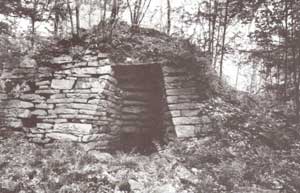|
 The fertile glades
around the headwaters of the Stonycreek River attracted
some of the earliest settlers - hard-working German
farmers. As settlers followed the Stonycreek northward,
support industries began to sprout in the early 19th
century: gristmills, sawmills and woolen mills. The fertile glades
around the headwaters of the Stonycreek River attracted
some of the earliest settlers - hard-working German
farmers. As settlers followed the Stonycreek northward,
support industries began to sprout in the early 19th
century: gristmills, sawmills and woolen mills.
The discovery of "bog ore" led to the establishment
of one of the region's earliest iron furnaces,
Shade Furnace, in 1807-1808 along the banks of Shade
Creek. Although isolated and entirely reliant upon Shade
Creek and the Stonycreek River for the transportation of
its iron, Shade Furnace operated until 1858 and evolved
into a typical 19th-century iron plantation (a complete
iron-working community) with a forge, foundry, gristmill,
and blacksmith shop. Early histories also make reference
to two other iron furnaces, the "Old Jackson Iron Furnace"
near present-day Quemahoning Lake and Rockingham Furnace
two miles upstream from Shade Furnace on Shade Creek.
The Baltimore and Ohio Railroad changed The Stonycreek
Corridor dramatically when it developed a branch line from
Somerset to Johnstown that largely followed the Stonycreek
River circa 1881. The B&O had been solicited by
officials of Johnstown's Cambria Iron Company, who were
dissatisfied with the Pennsylvania Railroad. Within 10
years, the PRR opened its own branch line into the
down-river section or northern end of the corridor. These
railroads effectively opened up the corridor to
large-scale lumbering and coal mining.
For
More History on early industry in The Stonycreek
Corridor click here and go to page 19. (2.4mb)
|

